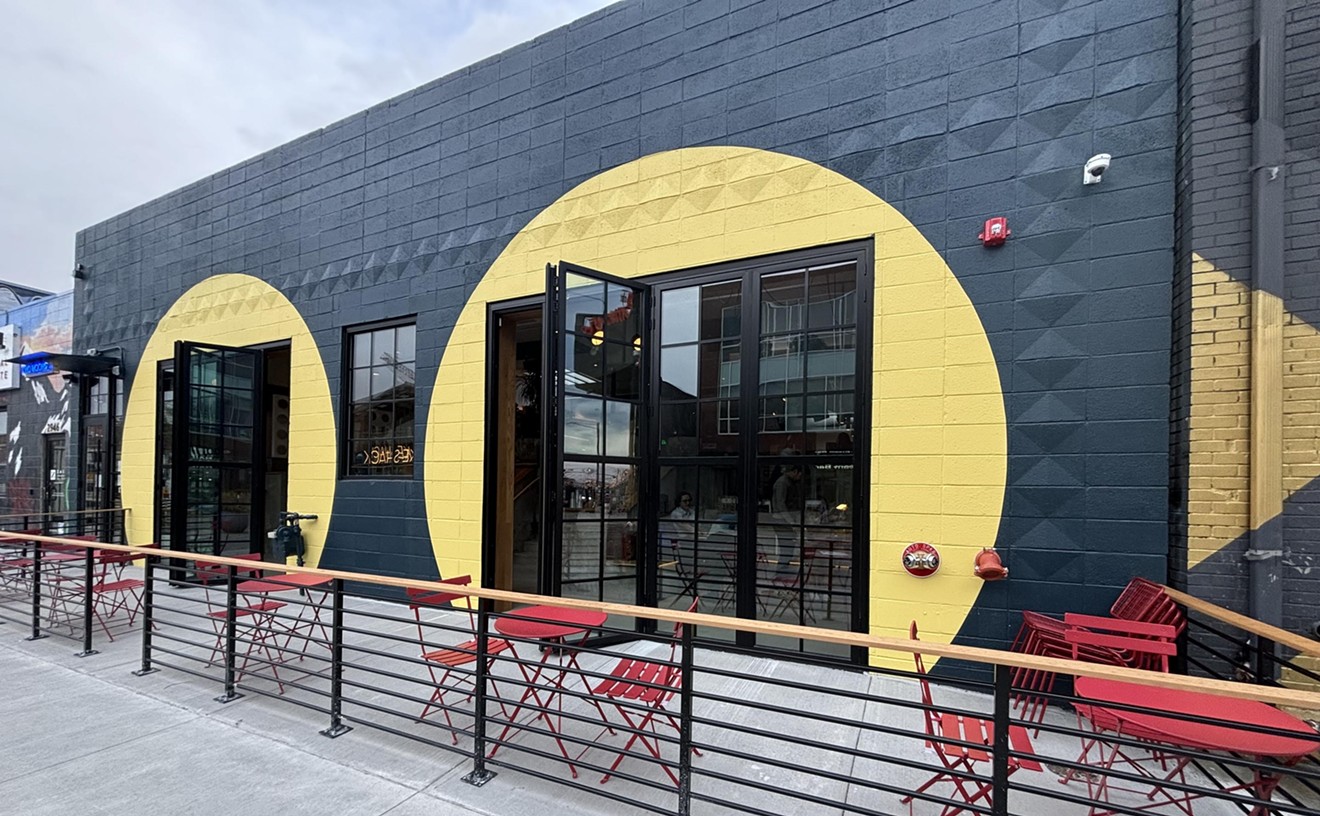There are so many albums I buy where people try to put in electronic sounds," says Jeffrey Stevens, "and it sounds like a cheap sticker on a wooden desk."
It might not sound like it, but Stevens is celebrating. The electronic alchemist, who is one half of Denver experimental pop outfit George & Caplin, is proud to unveil his latest project, Wentworth Kersey. Though the act sounds, by design, like a singer-songwriter, it's actually the product of an extremely unlikely collaboration. "We kind of grew up in this scene together, and we've always been in contact. And then Joe played my wedding, and six months later he called and said, 'I have a song.'"
The Joe in question is none other than Joe Sampson, whose rare solo performances and even rarer recordings as A Dog Paloma have reached near-mythic status around town. Though Sampson is most visible as a member of Bad Weather California, he's recorded literally hundreds (and possibly thousands) of songs on his own with just his guitar and his eight-track, few of which have seen the light of day beyond homemade CD-Rs shared with friends. In fact, though critics and musicians frequently cite Sampson as one of Denver's most important songwriters, the debut Wentworth Kersey EP will be his first official release.
"I've never finished anything in my life," Sampson confesses. "I have a 'boxed set' of 160 songs, but this is the first thing I've finished, and it's because it was out of my hands."
With characteristic humility, Sampson is all too eager to credit Stevens for creating Wentworth Kersey (the name comes from Stevens's and Sampson's middle names, respectively). "He does so much more in this project," Sampson insists. "It takes me no time at all — I have no choice in my creativity — and he spends hours on it. It would just be a Joe Sampson record if it wasn't for Jeff. What more could I do as a guy with a guitar in my hand? I can't keep reinventing myself."
Perhaps it was the desire to reinvent himself that sent Sampson to such an unlikely creative partner. Having recently put the Paloma name to bed and all but sworn off live performance, the scene veteran once seemed destined for retirement and desperate for something to renew his interest in music. While all of this happened relatively recently, the seeds of Wentworth Kersey were sown almost five years ago.
In 2004, electronic musician and multimedia artist Tyler Potts embarked on a mission to record and release one song per week for a full year. On the nineteenth week of the project, Potts completely reconfigured a Sampson song, "Blistering," turning the simple guitar-and-vocals track inside out with electronic blips and burbles.
"That was always one of my favorite songs," recalls Stevens, who has worked closely with Potts, as well as Justin Gitlin of CacheFlowe and Lui Ferreyra of Scaffolding. "It was ironic that Joe called me to do something. That was the blueprint."
Seconds into Wentworth Kersey's self-titled debut, however, it's clear that the duo did not set out to re-create Potts's songwriter-eaten-by-a-machine aesthetic. In fact, the record hardly sounds electronic at all. With the exception of one instrumental, composed and created entirely by Stevens, each track is built on Sampson's poignant songwriting, delicate vocal phrasing and diaphanous melodies that borrow from country, folk and indie rock. Stevens did very little to alter or enhance the intimate recordings that Sampson made with a single microphone and a single pass on his home eight-track. Instead, he jumped through innumerable electronic hoops and logged countless hours trying to match his entirely synthetic sonic landscapes to Sampson's unassuming and organic sound. The resulting illusion of an entire alt-folk ensemble is seamless and captivating.
"It's almost this quilt-like feeling," Stevens explains. "It was a different challenge from George & Caplin, where we work the vocals around the loops. With Joe, I had to find the pitches and loops that resonated with his song. The challenge was dumbing down the sounds. You could end up with Joe's performance sounding one way and the tracks sounding like two separate entities. Instead, I would mike sounds and put them on cassette tapes to get the right sound."
"If I put bass or drums on it," says Sampson, "it all sounds the same. I was sick of it all sounding the same. I had five songs that I didn't want to put anything to."
While fans of Sampson's songwriting and home recordings might disagree with his assessment, it is certainly true that the collaboration with Stevens has injected new life into his work. Stevens's electronic wizardry has essentially created Sampson's ideal backing band. The real power of the project, however, comes from the fact that each of the musicians has such a different background.
"If you listen to the album, it sounds like a '70s record with big orchestras and stuff, and I would never make that sound," insists Sampson. "I love old Leonard Cohen albums, and it kind of has that Cohen-Spector feel."
"But I was aiming for Ennio Morricone and Scott Walker," Stevens notes with a laugh. And it's that tension between the two musicians' reference points that makes Wentworth Kersey work so well.
"I feel like Joe's pushed me a lot to think of things differently," Stevens says enthusiastically. "He'll play records for me, and I interpret the sound differently than he hears it, and the error in interpretation makes it engaging. There wouldn't be that tug and pull and tension if we actually heard things the same way. The fact that it's almost off is what makes it function. It becomes this weird mess, and the uniqueness and identity comes from that. If it worked perfectly, Joe could fire me and have a band. Or I could fire him."
Not particularly fond of the spotlight, Sampson might not even mind being fired. "All these people say I'm their favorite songwriter, and that's really hard," the singer admits. "And with Wentworth Kersey, I'm not the forefront; I get buried by both of us. In a way, we're smothering me with us, and that made it so much easier. That doesn't mean I don't want to do it on my own, but it's easier to hide behind Wentworth Kersey than to do my own stuff."
Considering the confessional nature of much of Sampson's songwriting, it might not seem like he's hiding at all. However, this admission gives insight into how he views himself within a scene that frequently sings his praises. "I always think I'm the underdog, and people love the underdog. You know his character's never going to go anywhere because he sabotages himself. People can choose him because he'll never make it, and they can say they knew that guy."
At the same time, Sampson's unassuming approach has liberated Stevens from some of his perfectionist tendencies. "A goal of mine has been loosening up, and the beauty of Joe's music is in the looseness, how casual it feels," he explains. "Letting that be what it is makes me more inherently flawed in my manipulation of sound." Like his partner, Stevens is also prone to self-deprecation. "I'm taking Joe and putting him in the Xerox machine, cutting it apart, putting it back together and copying it again. If anything, I'm just the guy in the copy room."
For now, the duo plans to record a trilogy of EPs together, and the second is already nearing completion. After those three records, it's likely that Wentworth Kersey will cease to exist as Sampson and Stevens once again head off in their different directions. As with all good music, the pleasure of the collaboration is ephemeral. For fear of wearing out their welcome, both musicians want to make their collaborative statement and then leave it in our hands, our ears and our minds.
"I just want to be referred to," Sampson concludes. "I want people to say, 'That's kind of a Joe Sampson sound.' That's my only goal in life, and it's better than being the biggest band in town."










